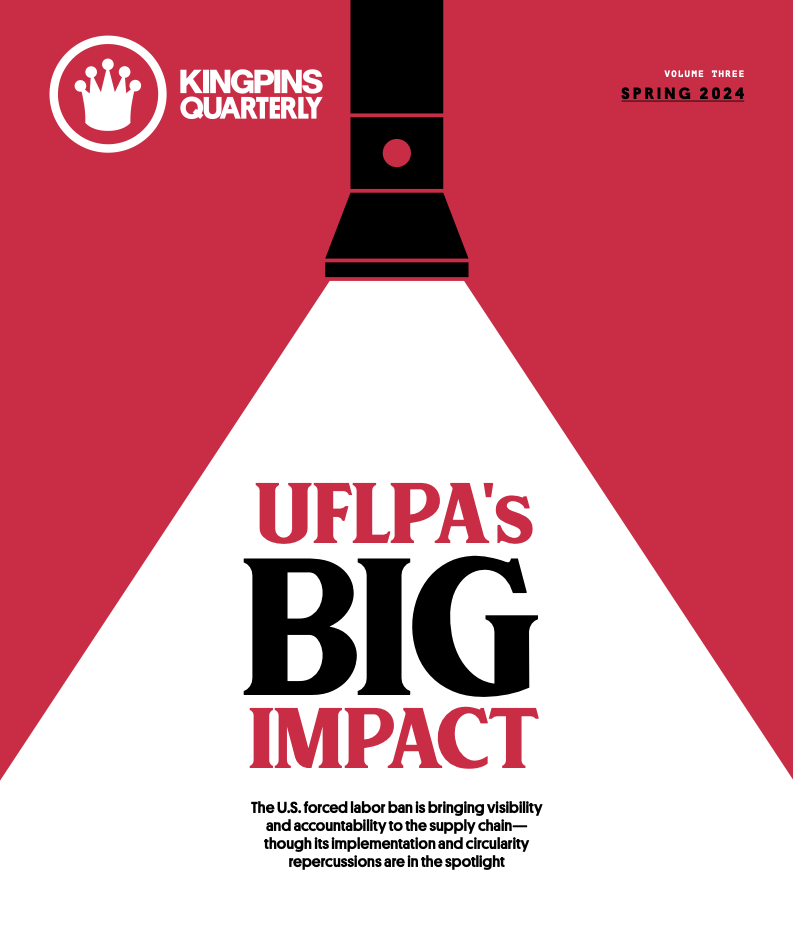With 2030 right around the corner, the industry has been focused on how to accelerate change—but the better question might be, is fashion racing toward a dead end?
A new report from the Transformers Foundation raises concerns about the complexities of the fashion industry’s climate commitments and the unfair burden they place on textile and apparel suppliers worldwide. Titled “Towards A Collective Approach: Rethinking Fashion’s Doomed Climate Strategy,” the report highlights what it calls a worrying disconnect between the pursuit of science-based targets and feasibility, equity and financing.
The report, which includes in-depth interviews with denim suppliers and stakeholders from major garment producing nations, was written by Elizabeth L. Cline, lecturer of Fashion Policy and Consumerism at Columbia University; Brooke Roberts-Islam, an industry expert and independent journalist; and Kim van der Weerd, Intelligence Director of Transformers Foundation.
Here, van der Weerd tells Kingpins Quarterly why one-size-fits-all makes about as much sense for sustainability as it does for a pair of jeans, what it will take to change the current top-down framework and why we don’t have any other choice than to equitably share the financial burden.
KPQ: “Doomed” is a strong word. Why do you think it’s an appropriate descriptor for the industry’s climate strategy?
KvdW: The primary findings of this report are that responsibility for climate action in fashion is not shared, it is largely a supplier responsibility. This approach is not only inequitable, it’s impracticable. One of the main ways that responsibility has been pushed down the supply chain is through the industry’s pursuit of science-based targets (SBTs). Most companies (for example, brands and retailers) setting SBTs are setting targets that cover their entire supply chain emissions (where most emissions are concentrated), but without input from their suppliers.
Suppliers also say they’re increasingly required or expected to set their own SBTs, which require individual companies to reduce their greenhouse gas emissions by about half by 2030 and achieve net zero by 2050. While seemingly egalitarian—by asking all companies along the value chain to set the same or similar targets to reduce emissions to the same extent—SBTs have institutionalized the logic that the work of decarbonizing fashion is the supply chain’s responsibility. And yet, because SBTs are set without consideration of feasibility and context, many suppliers—through no fault of their own—are limited in their ability to deliver those targets.
What’s more, the industry is not engaging in a wider reckoning about funding. In practice, suppliers are not only expected to do most of the work to decarbonize, but to pay for it (even when no financial returns are possible). This not only goes against industry platitudes and established international frameworks, including the Paris Agreement, about a need for equitable and just transition, but it also ensures climate mitigation will stall.
KPQ: The dynamic in which brands dictate to suppliers seems to have existed since offshoring began, whether it’s been about price, quality or sustainability. How can the industry break out of it for the sake of combating climate change?
KvdW: I’m tentatively (naively?) optimistic that if anything can break this dynamic it’s climate change. A supplier once said to me: “when it comes to climate change, we either all win or we all lose.” I think this is true for many of the things that you list in your question, but it’s more obvious how and why this kind of statement is true for climate change. For example, if suppliers are forced to set targets that many of them—through no fault of their own—cannot achieve, then collectively, we will all fail. It doesn’t matter if one brand hits its targets if the rest of the sector is left behind. As an aside: that’s also why this “who should do how much” question—which is tackled in the paper—is so critical. If contextual factors mean that not all suppliers are in a position to realize aggressive emissions reductions, then some companies (whether suppliers or other value chain actors) have to do more. This is a conversation we need to be having, but aren’t…
KPQ: How will the new legislation in the EU and U.S. impact the current brand-supplier dynamic?
KvdW: In this paper we look at three examples of legislation striving to hold companies accountable for the climate impacts (CSDDD, CSRD, and the NY Fashion Act). Though they all try to do this in slightly different ways and make varied references to things like the role of purchasing practices, overall we felt that regulators are missing a chance to enable climate action in part by reinforcing targets as a solution and an end in themselves—rather than, say, unlocking collectively funding mechanisms or exploring reporting systems that require brands and retailers to disclose the extent to which they are investing financially in their supply chain’s decarbonization.
KPQ: What are some suggestions on how the burden can be shared in the denim industry?
KvdW: We define collective action as shared ownership and shared responsibility. This requires shifting responsibility for climate action from suppliers to one that’s shared across the apparel value chain. Climate action must be our problem. This includes sharing financial resources, but also other types of resources. No target, not even a differentiated target, is viable without collective action. I hope one of the contributions of this paper will be to give people a vocabulary for articulating how and why the sector’s current approach is not collective.
The first step towards collective action is decoupling the “who does how much” question from the “who pays” question. In other words, just because a company needs to deeply decarbonize to meet our collective climate goals, that does not mean they’re automatically responsible for paying the tab. These two pieces of the puzzle—where does the work need to be done and who pays—need to be solved separately. Contributions should be linked to ability to pay and could factor in equity, margins, and historical emissions, for example.
An example of a program that is not collective would be a brand lending to a supplier because in this case, the supplier is still the entity that takes the project and the credit risk, and also a loan has to be paid back.
Decoupling is the first and most important step towards a collective approach.
A Seat at the Table
Suppliers weigh in on how SBTs, collaboration and legislation play a role in the industry’s push toward decarbonization.
On the need for a collaborative approach: Suppliers are increasingly under pressure to set science-based targets. For instance, major brands are now incorporating environmental considerations into their supply chain selection. The collaborative approach should be adopted rather than imposing requirements on the manufacturers…. They’re saying we’re business partners, but at the time of implementation, nobody is there to support us. That is the biggest challenge. – Saqib Shahzad, head of sustainability for Sapphire, parent of Diamond Denim mill located in Pakistan
On incentivizing change: The legislation needs to build a very well-defined competitive edge for sustainable transformation, a way to really measure it as well as incentivize it. Otherwise, it’s going to again be all open in the air. And I think the manufacturer perspective is not fully there within the legislation so that needs to be integrated more into how the frameworks are defined. If we’re involved with policies and legislations, we’re all ready to contribute. – Ebru Debbag, executive director, global sales and marketing for Pakistan-based mill, Soorty
On the price of sustainable innovation: For the last 12 to 15 years, the average cost of a basic five pocket is $6… A sustainable garment [that] consists of durability, that is manufactured with renewable energy and has recyclability that makes it environmentally friendly costs $9. [Brands] are saying ‘Okay, this is a good sustainability initiative, but we are willing to have a $6 garment at the moment and maybe in future we will consider it.’ The brand isn’t willing to pay an additional amount, and the same [for] the consumer. – Saqib Shahzad
On how to move the conversation past prices: One example regarding a collective approach is recently [the International Apparel Federation] signed an agreement with the Inditex Group to try to define some rules and guidelines… I think we need this kind of approach with the Federation representing the producers. If we come together like IAF did, then we can have a seat at the table. Otherwise, if we do it, there’s so much [disconnect] between what the management is announcing with the science-based targets and the purchasing practices that are applied on a daily basis. – Romain Narcy, partner at the Ereks- Blue Matters mill in Turkey
On how to bring all stakeholders into the conversation: [We need] a collaborative approach rather than a transaction-based approach in which brands and suppliers can sit down together to formulate three-year long plans on how they are going to [mediate] a collaborative decarbonization. And the other thing is… the more we can collaboratively make this information available as to where [consumers’] investments are going, what they are supporting, there’s the need for that in the market. – Ebru Debbag




